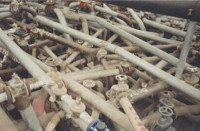Designing for safety
Inherent safety, designed in
Overview

System safety is the application of engineering and management principles, criteria, and techniques to optimize all aspects of safety within the constraints of operational effectiveness, time, and cost. It is a planned, disciplined and systematic approach to preventing or reducing accidents throughout the lifecycle of a system.
Important principles applied in system safety include inherent safety and defence in depth (use of multiple, independent safety barriers).
This submodule is a part of the hazard analysis module.
Learning objectives
Upon completion of this module, you should be able to:
understand inherent safety techniques
be able to explain the principle of defence in depth
distinguish between passive and active safety mechanisms
Course material
 |
Design for safety Learn about the principles of safe design, including inherent safety
(minimize/substitute/moderate/simplify), defence in depth, safety factors, negative feedback, and
design for controllability. Distinguish between passive and active safety mechanisms.
|
Designing for safety involves the use of:
Design principles such as fail-safe design, reduction of the level of coupling between system components, designing for controllability (incremental control, negative feedback mechanisms, simplification), defence in depth, and following the hierarchy of controls.
Active protection mechanisms such as safety valves, rupture disks, interlock devices, safety instrumented systems and lock-out/tag-out or LOTO procedures.
Other resources
We recommend the following sources of further information on this topic:
Book Engineering a safer world — systems thinking applied to safety by Nancy Leveson (MIT Press, 2012), ISBN: 978-0262016629. Can be purchased in hardcover or downloaded in PDF format for free.
INSAG-10 report Defence in Depth in Nuclear Safety, from IAEA.
Inherently Safer: The Future of Risk Reduction, a US CSB safety video on inherent safety concepts.
A collection of case studies on the safety of complex systems, put together by the Engineering X community at the UK Royal Academy of Engineering.
The US FAA’s System Safety Handbook is freely available online.
US NIOSH’s Prevention through Design initiative aims to help you “design out” hazards and risks.
Safe machinery handbook by Schneider Electric, with useful information on the EC Machinery Directive and design principles.
Published:
Last updated: